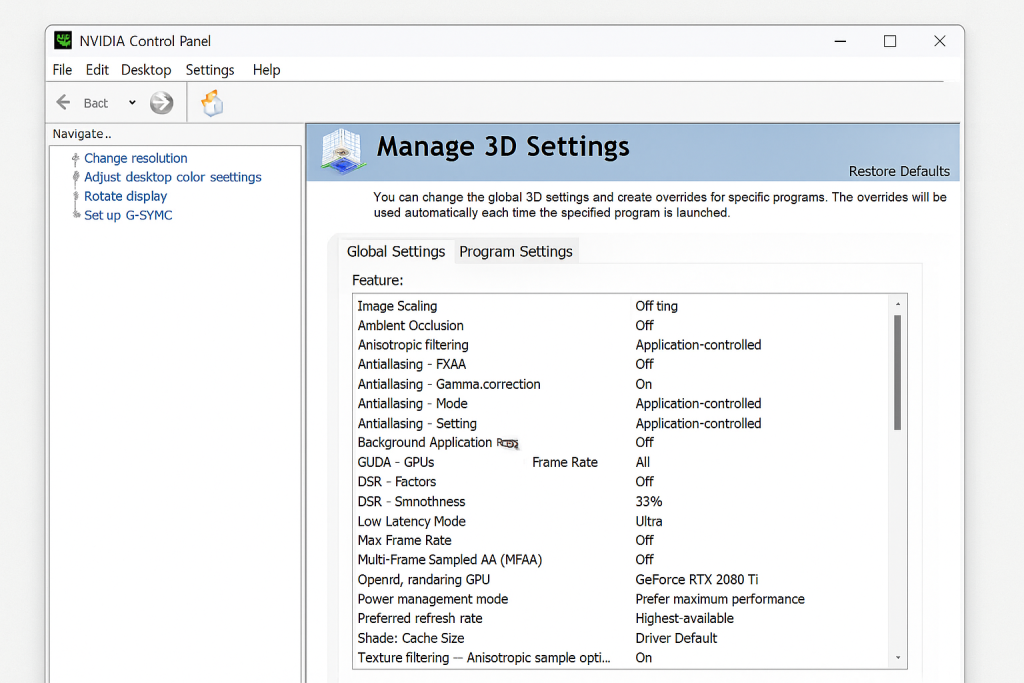⏲️ Estimated reading time: 4 min
🎮 Best Nvidia Control Panel Settings for RTX 2080 Ti – Ultimate Guide. Unlock the full potential of your RTX 2080 Ti with optimized Nvidia Control Panel settings. This step-by-step guide covers performance tweaks, image quality adjustments, and advanced features to help you achieve the best gaming and productivity experience possible.
The Nvidia GeForce RTX 2080 Ti is a powerhouse graphics card capable of handling demanding games, VR applications, and creative workloads. However, many users don’t fully optimize their settings in the Nvidia Control Panel. By adjusting these configurations, you can balance performance, image quality, and responsiveness to suit your needs.
This guide will walk you through the best Nvidia Control Panel settings for the RTX 2080 Ti, whether you want maximum FPS, smooth visuals, or a hybrid balance between the two.
Step 1: Open Nvidia Control Panel
- Right-click on your desktop.
- Select Nvidia Control Panel from the menu.
- If it doesn’t appear, update your Nvidia drivers via GeForce Experience.
Step 2: Adjust 3D Settings
Manage 3D Settings → Global Settings
These settings affect all applications by default. You can also tweak them individually under Program Settings for specific games.
- Image Sharpening: On (Sharpening: 0.5, Ignore Film Grain: 0.17) – enhances clarity.
- Anisotropic Filtering: Application-controlled.
- Antialiasing – FXAA: Off (unless needed for older games).
- Antialiasing – Mode: Application-controlled.
- CUDA GPUs: All.
- Low Latency Mode: On (or Ultra for competitive games like CS2, Valorant, Fortnite).
- Max Frame Rate: Off (or set to match your monitor’s refresh rate if desired).
- Multi-Frame Sampled AA (MFAA): On.
- OpenGL Rendering GPU: Select RTX 2080 Ti.
- Power Management Mode: Prefer Maximum Performance.
- Preferred Refresh Rate: Highest Available.
- Shader Cache Size: Unlimited.
- Texture Filtering – Anisotropic Optimization: On.
- Texture Filtering – Negative LOD Bias: Allow.
- Texture Filtering – Quality: High Performance (for max FPS) or Quality (for visuals).
- Threaded Optimization: Auto.
- Triple Buffering: Off (enable only if you use V-Sync).
- Vertical Sync (V-Sync): Off (unless screen tearing bothers you).
- Virtual Reality Pre-Rendered Frames: 1.
Step 3: Configure Display Settings
Adjust Desktop Color Settings
- Increase Digital Vibrance to 60–70% for richer colors.
- Adjust brightness/contrast according to preference.
Change Resolution
- Ensure your monitor runs at native resolution (e.g., 1920×1080, 2560×1440, or 4K).
- Set refresh rate to maximum supported (144Hz, 165Hz, or 240Hz).
G-Sync Settings
- If your monitor supports G-Sync, enable it:
- Enable G-Sync for fullscreen mode (or both fullscreen and windowed if preferred).
- Combine with V-Sync = Off inside Nvidia Control Panel, and On in-game for smooth results.

Step 4: Configure PhysX
- Go to Set PhysX Configuration → Select RTX 2080 Ti instead of Auto.
This ensures the GPU handles all PhysX effects.
Step 5: Optimizations for Specific Use Cases
For Gaming (FPS Boost)
- Power Management Mode → Maximum Performance.
- Low Latency Mode → Ultra.
- Texture Filtering Quality → High Performance.
- Disable V-Sync, enable G-Sync if available.
Content Creation (Video Editing/3D Work)
- Texture Filtering Quality → Quality.
- Low Latency Mode → Off.
- Enable higher Antialiasing for smooth previews.
For Hybrid Use (Balanced)
- Power Management Mode → Normal.
- Texture Filtering Quality → Quality.
- Low Latency Mode → On.

Step 6: In-Game Settings vs. Control Panel
- Always let games control resolution and graphics quality.
- Use Nvidia Control Panel overrides only for global preferences or problematic games.
Extra Tips
- Update drivers regularly via GeForce Experience.
- Use Nvidia DLSS in supported games for higher FPS.
- Benchmark your setup using tools like MSI Afterburner, 3DMark, or in-game benchmarks.
- Create different profiles per game in the Nvidia Control Panel if you want fine control.
⚡ Final Thoughts
The RTX 2080 Ti remains a strong GPU for both gamers and creators. By fine-tuning the Nvidia Control Panel settings, you can maximize its potential for smooth, stable, and visually stunning performance. Whether you prefer FPS optimization or cinematic visuals, the right setup ensures you’re getting the best from your hardware.
🔔 For more tutorials like this, consider subscribing to our blog.
📩 Do you have questions or suggestions? Leave a comment or contact us!
🏷️ Tags: Nvidia Control Panel, RTX 2080 Ti, Best Settings, Gaming Performance, PC Optimization, High FPS, G-Sync, V-Sync, Overclocking, GeForce Experience
📢 Hashtags: #Nvidia #RTX2080Ti #GamingSetup #BestSettings #FPSBoost #PCGaming #GraphicsCard #GSync #Esports #TechGuide
Only logged-in users can submit reports.
Discover more from HelpZone
Subscribe to get the latest posts sent to your email.

